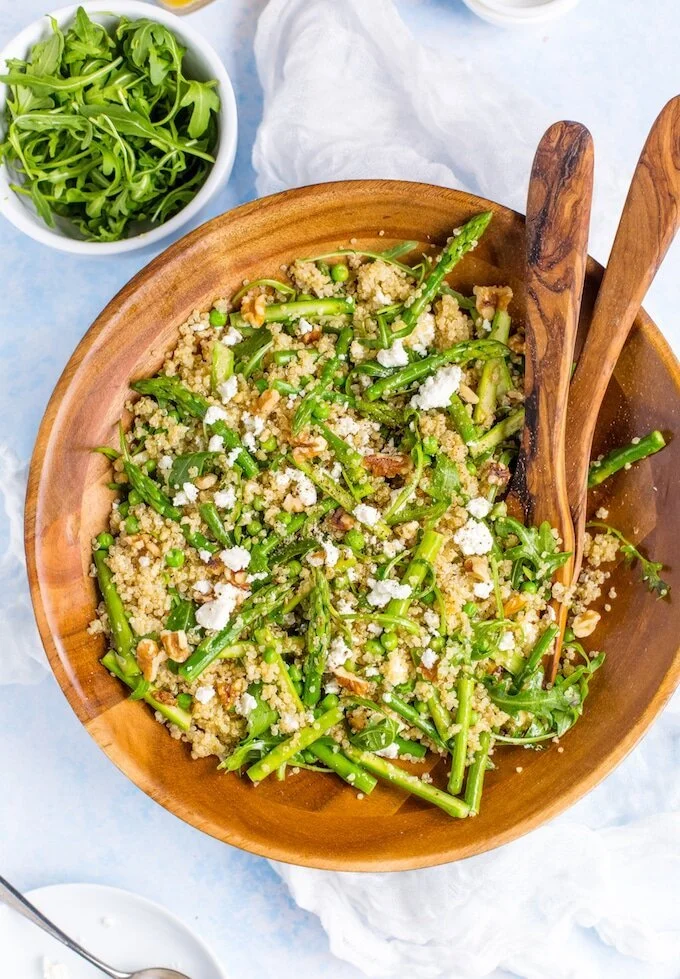Asparagus Recipe: Spring Tabouli
Asparagus, officially known as Asparagus officinalis, is a member of the lily family. This popular vegetable comes in a variety of colors, including green, white and purple. Asparagus is also low in calories and packed with essential vitamins, minerals and antioxidants.
ASPARAGUS IS:
a low-calorie vegetable that is an excellent source of essential vitamins and minerals, especially folate and vitamins A, C and K.
a good source of antioxidants, including vitamins C and E, flavonoids and polyphenols. Antioxidants prevent the accumulation of harmful free radicals and may reduce your risk of chronic disease.
a good source of antioxidants, including vitamins C and E, flavonoids and polyphenols. Antioxidants prevent the accumulation of harmful free radicals and may reduce your risk of chronic disease.
high in folate (vitamin B9), an important nutrient that helps reduce the risk of neural tube defects during pregnancy.
As a good source of fiber, asparagus promotes regularity and digestive health and may help reduce your risk of heart disease, high blood pressure, and diabetes.
Asparagus contains potassium, a mineral that can help lower high blood pressure.
In addition, animal research has found that asparagus may contain an active compound that dilates blood vessels, thus lowering blood pressure.
Asparagus has a number of features that make it a weight-loss-friendly food.
It’s low in calories, high in water, and rich in fiber.
It also contains a small amount of soluble fiber, which dissolves in water and forms a gel-like substance in the digestive tract.
Soluble fiber feeds the friendly bacteria in the gut, such as Bifidobacteria and Lactobacillus Increasing the number of these beneficial bacteria plays a role in strengthening the immune system and producing essential nutrients like vitamins B12 and K2.
Eating asparagus as part of a fiber-rich diet is an excellent way to help meet your fiber needs and keep your digestive system healthy.
Asparagus is a delicious and versatile vegetable that’s easy to incorporate into your diet.
Add it to salads, frittatas, omelets, and stir-fries.
It can be cooked in a variety of ways, including boiling, grilling, steaming, roasting, and sautéing.
Furthermore, it’s extremely affordable and widely available.
When shopping for fresh asparagus, look for firm stems and tight, closed tips.
SPRING TABOULI (AKA QUINOA ASPARAGUS SALAD)
Yield: 4-6
A simple recipe for Quinoa Asparagus Salad ( aka Spring Tabouli) tossed with English peas, fresh dill, parsley, toasted almonds in a lemony dressing topped with optional avocado, goat or feta cheese.
Ingredients:
1 cup quinoa (dry)
1 1/2 cup water
Pinch salt
1 bunch asparagus, chopped into 1 inch pieces
2 cups shelled fresh English peas or substitute shelled edamame, radishes, cucumber, snow peas or even spring greens.
3 scallions – thinly sliced at a diagonal
½ cup fresh dill ( 2 x .5 ounces packages) chopped ( or sub Italian parsley)
½ cup Italian parsley, more to taste.
1/4 cup sliced or slivered almonds, toasted ( optional, or sub other nut or seed)
Dressing:
1/3 cup organic Extra virgin olive oil
zest from 1 lemon
1/3 cup fresh lemon juice ( 1–2 lemons)
1/2–1 teaspoon kosher salt
pepper to taste
Optional and delicious garnishes: crumbled goat cheese or feta, sliced avocado, sunflower sprouts or pea shoots, flower petals, and chive blossoms are nice.
Instructions:
Rinse the quinoa and place it in a pot with the water and pinch of salt. Bring to a boil, cover, lower heat, and allow it to simmer on low heat for 12-15 minutes. Turn off heat, and let sit covered for 5 -10 minutes, then uncover, fluff with a fork and let it cool.
While the quinoa is cooking, blanch the peas and asparagus in salted boiling water for just a few minutes, until bright and tender. Rinse under cold water.
Place the cooled quinoa and blanched veggies in a bowl. Add the scallions, dill and almonds and give a toss. Add the oil, lemon zest and lemon juice and salt, pepper and stir again.
Taste, adjust salt and lemon, adding more if you like. If you are making this ahead, be sure to taste before serving as flavors will mellow – so I’ll usually add a little more salt and lemon.
Serve with optional avocado, feta, goat cheese, sunflower sprouts.
If making this ahead – be sure to taste this right before serving and adjust salt and lemon once more -because quinoa has a tendency to soak up all the flavor! Wait until serving to add any cheese, sprouts or avocado, so salad looks beautiful and fresh.



